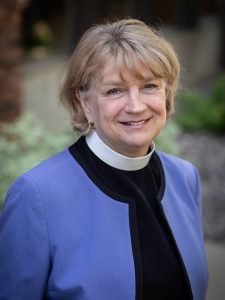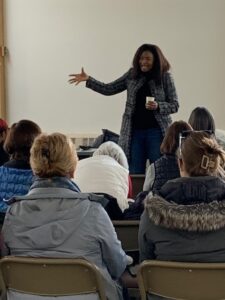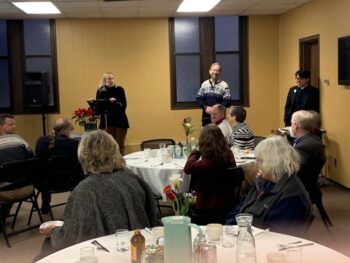 By Bishop Ann Svennungsen
By Bishop Ann Svennungsen
What images and metaphors do you use to describe your congregation? Scripture provides a few: the body of Christ, the flock of the good shepherd, the vine and the branches.
At our recent Bishops Academy, Bishop Kurt Kusserow invited us to think more deeply about the metaphors we use – especially the “built-in success meters” inherent in each.

Angela Harrison, a relative of George Floyd, participates in a panel of George Floyd Square Memorial leaders, with ELCA bishops from around the country. San Pablo/Saint Paul’s Lutheran Church, Minneapolis, hosted the conversation.
“If the specter of the decline in the ELCA is not the final measure of the efficacy of God’s work in the world, we need to find new metaphors to guide us.”
We know what a healthy body looks like. There are metrics we use: heart rate, blood pressure, weight, infection, fitness. When we look out over our congregation and see just a handful of worshipers scattered across a vast sanctuary, we may sense we “don’t meet the metrics of success.”
And, when we look across the whole ELCA, our concerns deepen. At its beginning in 1988, the ELCA had five million members. Today, it has three million. And, not only are the numbers declining, but the church’s structures are becoming more fragile.
WE WHO LEAD AND care for congregations and synods are anxious. By most metrics, we are not successful. And, it is to that anxiety that Bishop Kusserow spoke most powerfully. Referring to the Small Catechism and the Augsburg Confession, he called us back to our faith: It is “God who calls, gathers, enlightens, and sanctifies the whole Christian church on earth,” and this “one holy Church is to continue forever.”
If we stand on the promise that the church is God’s work, an abiding work for the sake of the world, then we may need to look for new images to describe Christian community. If the specter of the decline in the ELCA is not the final measure of the efficacy of God’s work in the world, we need to find new metaphors to guide us.
“When we look out over our congregation and see just a handful of worshipers scattered across a vast sanctuary, we may sense we ‘don’t meet the metrics of success.’”
Bishop Kusserow suggested the image of “women watching and witnessing.” In the Gospels, women were present at the most significant moments: birth, crucifixion, burial, resurrection. They did not turn away. They watched; and they told the story.

Rostered leaders at Holy Trinity Lutheran, Minneapolis, shared reflections on the 2020 Uprising in the congregation’s neighborhood. The Third District Police Precinct was located just one block from Holy Trinity. Many of the buildings surrounding Holy Trinity were destroyed.
The success meter for “watching and witnessing” is radically different from that of a healthy grapevine. The women saw events – not of their own making. They watched and told others about things external to themselves. And, though small in number, their witness mattered.
THE DAY BEFORE Bishop Kusserow gave his lecture, the bishops spent time with the “keepers of George Floyd Square,” primarily women who gather twice daily in the square to bear witness to the cruelty of racism and the vision of God’s justice. Perhaps, they are the Mary Magdalenes of today. And, perhaps, they might inspire us to recognize a new image of church:
- a gathering of people who watch, not turning away from the agony of the world, but bringing it to God; and
- a gathering of people who witness, sharing the hope and vision of redemption by God’s grace.
God fill us with strength and hope as we participate in God’s abiding work through the church.
